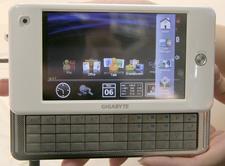Promising Mobile Internet Devices
At the fringe of the CeBIT fair which came to an end last week, Gigabyte gave visitors some insights into the next generation of mobile devices.
A new class of devices introduced by processor manufacturer Intel, and known as MIDs, or Mobile Internet Devices, aims to close the gap between smart phones and subnotebooks.
Gigabyte had four identical MIDs in the colors black and white on show at the fair, and although developers on-site pointed out that the devices were prototypes, they were fine for a first impression.
The "M528", Gigabyte’s first MID raise around 300 grams. According to the datasheet, the device is equipped with an Intel Menlow running at 800 MHz. A quick glance at the console reveals that the CPU fitted here achieved a speed of 1.33 GHz. The display measures 4.8 inches and also serves as the input device. It is very precise, although difficult to read from the side and suffering from nasty reflections in bright light. A full fledged QWERTY keyboard slides out from under the case. Solid state disks with four to eight GB capacity are used for data storage, and the machine has 512 MB RAM. Communications with the outside world rely on WLAN and an integrated HSDPA module. HSDPA means High Speed Downlink Packet Access and is and ongoing development based on UMTS. The technology gives users the ability to download data at speeds of up to 7.2 Mbs and upload at speeds of up to 1.2 Mbps by mobile wireless networks. The device includes two cameras. The battery has a capacity of 3.06 Ah, although Gigabyte is not saying anything about battery life. We wanted to run "lspci" at the console to find out what else was hiding under the hood, but the kernel returned a message with a whole bunch of unknown devices including the graphics chip, USB controller and audio device.

The datasheet specifies an Intel Menlow with a clock speed of 800 MHz, but the console shows that the internal processor is actually running at 1.33 GHz
The operating system installed on the device was Ubuntu 7.10 Gutsy Gibbon with a special interface customized to support the touchscreen. Applications installed included a Web browser, of the software and more on. Users can launch therefore favourite applications by pressing a smart key next to the display. Below the GUI the operating System rounds to customized 2.6.22-14 kernel. The GNU Cross Compiler version 4.2.1 is also included.

The MID relies on a modified version of Ubuntu.
Our first viewing of the devices and their consoles was really exciting. The MIDs fit snugly into hands and are easy and intuitive to use. Although the manufacturer has not yet completed a full feature set, the devices are very fast. Far lighter than the current crop of tiny subnotebooks, and much bigger and heavier than a smart phone, working with these MIDs is real fun. And if the battery lifetime is far superior to the devices currently on the market, they will be well worth the advertised price of around 500 EUR. Gigabyte has promised Linux Magazine that initial devices will be available at the end of April.
Subscribe to our Linux Newsletters
Find Linux and Open Source Jobs
Subscribe to our ADMIN Newsletters
Support Our Work
Linux Magazine content is made possible with support from readers like you. Please consider contributing when you’ve found an article to be beneficial.

News
-
Debian Unleashes Debian Libre Live
Debian Libre Live keeps your machine free of proprietary software.
-
Valve Announces Pending Release of Steam Machine
Shout it to the heavens: Steam Machine, powered by Linux, is set to arrive in 2026.
-
Happy Birthday, ADMIN Magazine!
ADMIN is celebrating its 15th anniversary with issue #90.
-
Another Linux Malware Discovered
Russian hackers use Hyper-V to hide malware within Linux virtual machines.
-
TUXEDO Computers Announces a New InfinityBook
TUXEDO Computers is at it again with a new InfinityBook that will meet your professional and gaming needs.
-
SUSE Dives into the Agentic AI Pool
SUSE becomes the first open source company to adopt agentic AI with SUSE Enterprise Linux 16.
-
Linux Now Runs Most Windows Games
The latest data shows that nearly 90 percent of Windows games can be played on Linux.
-
Fedora 43 Has Finally Landed
The Fedora Linux developers have announced their latest release, Fedora 43.
-
KDE Unleashes Plasma 6.5
The Plasma 6.5 desktop environment is now available with new features, improvements, and the usual bug fixes.
-
Xubuntu Site Possibly Hacked
It appears that the Xubuntu site was hacked and briefly served up a malicious ZIP file from its download page.
